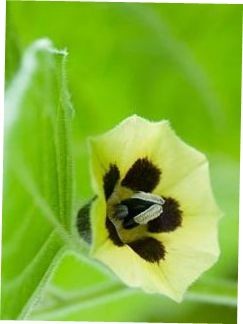Cape gooseberry
(Nicandra physalodes)

Description
Physalis peruviana, is a South American plant native to Colombia, Ecuador and Peru in the nightshade family (Solanaceae), commonly known as Cape gooseberry or goldenberry, known in its countries of origin as aguaymanto, uvilla or uchuva, in Hawaii called poha, and in Egypt called Harankash, in addition to numerous indigenous and regional names. The goldenberry is also known as ground cherry. The history of P. peruviana cultivation in South America can be traced to the Inca Empire. It has been cultivated in England since the late 18th century, and in South Africa in the Cape of Good Hope since at least the start of the 19th century. Widely introduced in the 20th century, P. peruviana is cultivated or grows wild across the world in temperate and tropical regions. P. peruviana is an annual in temperate locations, but perennial in the tropics. As a perennial, it develops into a diffusely branched shrub reaching 1–1.6 m (3 ft 3 in – 5 ft 3 in) in height, with spreading branches and velvety, heart-shaped leaves. The hermaphrodite flowers are bell-shaped and drooping, 15–20 mm (5⁄8–3⁄4 in) across, yellow with purple-brown spots internally. After the flower falls, the calyx expands, ultimately forming a beige husk fully enclosing the fruit. The fruit is a round, smooth berry, resembling a miniature yellow tomato 1.25–2 cm (1⁄2–3⁄4 in) wide. Removed from its calyx, it is bright yellow to orange in color, and sweet when ripe, with a characteristic, mildly tart grape- or tomato-like flavor. A prominent feature is the inflated, papery calyx enclosing each berry. The calyx is accrescent until the fruit is fully grown; at first, it is of normal size, but after the petals fall, it continues to grow until it forms a protective cover around the growing fruit. If the fruit is left inside the intact calyx husks, its shelf life at room temperature is about 30–45 days. The calyx is inedible. Physalis peruviana is native to the mountain slope regions of Peru and Chile. It grows in forests, forest edges, and riparian areas. It grows at high elevations of 500–3,000 m (1,600–9,800 ft) in its native region, but may also be found at sea level in Oceania and Pacific islands where it occurs widely in subtropical and warm, temperate conditions. Its latitude range is about 45°S to 60°N, and its altitude range is generally from sea level to 3,000 m (9,800 ft). The plant has become invasive in some natural habitats, forming thickets, particularly in Hawaii and on other Pacific islands.
Taxonomic tree:







